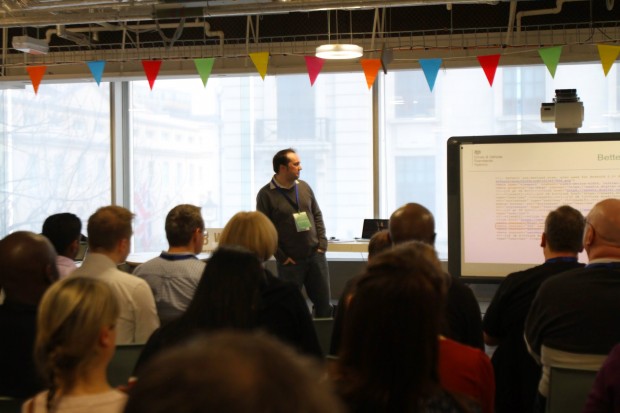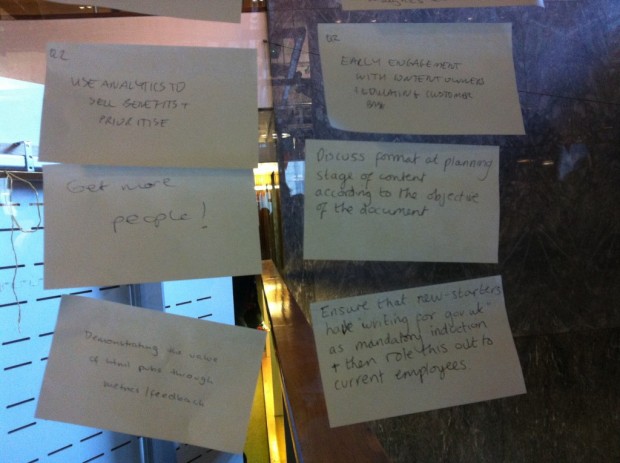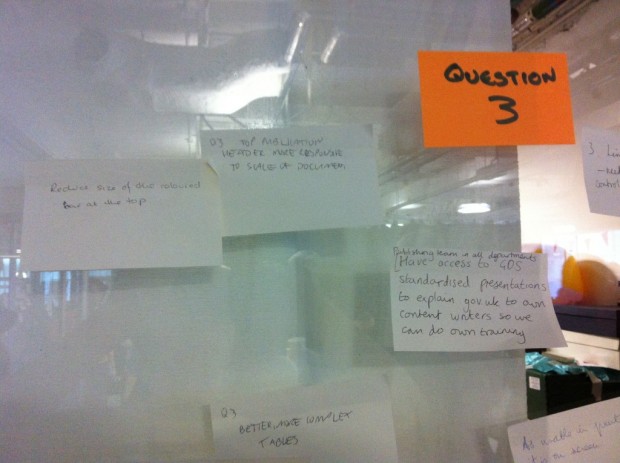At GOV.UK's first content design conference I talked about HTML publications and then blogged about why I think they're so important at GOV.UK.
As part of our session we broke into groups to answer 3 questions:
- what’s stopping us from adopting HTML publications more widely?
- what can we, as content designers, do to overcome these barriers?
- what can GDS do to improve the HTML publication format?
Here are some of the things that people said.
Things that stop us from adopting HTML publications more widely
HTML publications may not be adopted more widely because:
- content in PDF is too complex or detailed to present in HTML
- people read PDFs in a different way to HTML
- printing isn’t as clear as with a PDF
- technical users like interactive PDFs
- of the quality of content and time needed to edit it
- of the contractual basis of the document
- of a lack of time and skills to convert to HTML
- there needs to be more understanding of user needs
- the documents are very long and it's hard to scroll on screen
How we, as content designers, can overcome these barriers
Our group suggested that we could tackles these challenges by:
- using analytics to sell benefits and prioritise
- getting more people
- demonstrating the value of HTML publications through metrics and feedback
- early engagement with content owners and by educating the customer base
- discussing format at the planning stage of content according to the objective of the document
- ensuring that new-starters have ‘Writing for GOV.UK’ as an induction and then roll this out to current employees
- designing content well leading up to the full PDF
- using the reasons to use them that you gave us today will definitely help convince people to use them more
How GDS could improve the HTML publication format
Our group's wishlist included:
- better tables, eg adding table editor
- more flexibility with numbered points
- the top publication header to be more response to the scale of documents
- to reduce the size of the coloured bar at the top
- a printing format
- change notes to be clearer so that they can track versions
- line breaks so that we can control spacing
I realised when writing this post that I hadn't added my own to the list. My number 1 would have to be this one for GDS: stop labelling them as ‘HTML’ on GOV.UK. We shouldn’t expect users to know what HTML is, so let’s call them webpages or pages – or even look at removing the label if it’s not helping users.
Thanks for coming
Finally, a big ‘thank you’ to everyone who came to the session and took part.
And a special thank you to Elena from GDS for helping to run the session and answering the questions for GDS.
We're having a GOV.UK meet-up in Nottingham on 19 February. All government content designers are welcome.




 The GOV.UK app went live in public beta in July 2025. Find out what’s been happening, and what’s coming next,
The GOV.UK app went live in public beta in July 2025. Find out what’s been happening, and what’s coming next,
5 comments
Comment by Antony Hopker posted on
I like the idea of stop calling them html publications, and in the same breath I'd ask if any user knows the difference between a detailed guide or guidance, except the number of clicks to get to it.
A format called a 'page' where you could add 'text' or 'attachments' wherever the flow needed them would be nice and simple (and make conversations with policy colleagues an awful lot easier).
Comment by Greg Morgan posted on
Hi John
html v pdf is an interesting debate. At DfE we undertook some research into content quality, one of our objectives being to discover if our users (primarily people working in schools, local authorities, early years and children's services) had a preference for consuming long-form content as either html or pdf. While the results weren't entirely conclusive there was a slight preference expressed for pdf. One of the reasons given was the ability to save documents to a desktop for reading offline.
I'd be interested in hearing if you (or others) have discovered that users prefer html over pdf, and if so what reasons were given.
One of the main obstacles to persuading policy teams to publish in html publication or detailed guide format is the fact that content in pdfs isn't spot checked, so doesn't have to comply with the GOV.UK content principles and style guide. Often the content team here will be given a few days notice to publish some content, and it simply isn't possible to rewrite it to comply with the style guide and get it approved in that time.
Greg
Comment by John Ploughman posted on
Hi Greg.
There are a few really interesting points here.
On the HTML vs PDF for users point, we've been focusing on looking at how users are viewing content. A lot of our users are out on the road, checking information on mobile devices (when they're not driving, of course).
So it really makes things better for them to have HTML content that works well on mobile devices.
The main reasons I've seen for users expressing a preference for PDF over HTML are either reading offline or wanting to print.
On print, I hope that we'll see some improvements to the print style sheets on GOV.UK. We need users to be able to print an HTML publication that looks great.
On offline reading, it'll be interesting to see what GDS can do to meet that need - eg generating a PDF from the HTML version which can be saved.
The point about policy teams providing content too late was something that was raised at the session. A few suggestions that came up included telling them about the benefits of HTML, and trying to build up better relationships with them to avoid getting content too late.
In my experience, people who want to avoid having content that follows the style guide usually don't understand why we have it.
I think part of our job as Content Designers is to help them learn about the good stuff at https://www.gov.uk/guidance/content-design/writing-for-gov-uk.
When they learn more about it, very few would (I hope) choose to ignore evidence, insight and research about how people read. Or choose to make things harder for people. Or choose to exclude people.
If anyone has experience of helping policy colleagues and what's worked or not worked for them, I'd love to hear more about it. I think it's something a lot of us would benefit from doing in our organisations.
John
Comment by E. Brown posted on
Hi John,
You said:
"In my experience, people who want to avoid having content that follows the style guide usually don't understand why we have it."
I think you're reading too much into the actions of people who 'want to avoid having content that follows the style guide'.
You're certainly making them out to be the problem, 'choos[ing] to ignore evidence, insight and research about how people read'.
I don't see them 'wanting to avoid having content that follows the style guide'.
I see them wanting to *retain control* over their own text and content that they have busted their butts to see through the process of meetings, revisions, drafts edits and signoffs.
That's what most publishing in the public service requires.
(I was part of a guidance group recently, developing new guidance in a health protection setting at a demanding pace. The summary of 'how to develop new guidance' ran to to a 'brief' 15 PPT slides.)
Authors do not want to see weeks and months of work undone by someone on the digital team at the 11th hour.
Any author on the point of publishing, discovering that the digital team requires changes that might undo their efforts, are liable to resist those changes, no matter how worthy.
Authors in that situation want to find the path of least resistance: in this case, publishing to PDF that requires the fewest changes to their content.
On top of that: you're telling educated adults, many of whom write expert content for a living, how to write. You're telling them, 'yer doin' it wrong'.
Many authors reach their positions in the public service with writing skills that have served them well, that do not conform to the GOV.UK style.
It's the rare person who welcomes hearing that their writing is not acceptable, that they must change it in order to publish, and must revise their content to meet GOV.UK standards.
The reasons behind it don't matter: it's the point of being told, 'nope, not good enough', that is the sticking point.
Ideally, those who publish content can work their way into the content development process earlier, so that content format, style and audience concerns are part of the discussion from the outset.
I look forward to seeing an example of that ideal process, with great interest.
Regards,
E. Brown
Comment by John Ploughman posted on
Hi
"In my experience, people who want to avoid having content that follows the style guide usually don't understand why we have it."
The important part here is "in my experience".
When I've sat down and explained why we have the style guide, they then understand why it's so important. I find that they weren't considering how people read differently online to offline, and how people are recognising the shape of words, rather than reading letter-by-letter.
I can't speak for experiences of others across government, and my intention isn't to generalise and say it's the same everywhere. But it's what I've found.
In my organisation, the point we've got to is asking for subject matter experts to send in a new user need in the form of a user story. We don't ask them to send us content.
The content design team then works out the best way to meet that need with the subject matter expert. This avoids us getting content sent to us with an expectation that it's published 'as is'.
I think the other point is getting people away from seeing things as "their text". It's not. It's going into the public domain, on something like the 26th most popular website in the country. It belongs to the people that will be using it.
The more that we can help spread the message that this is about meeting user needs through evidence and research, the easier our jobs will become. And we'll make things better for users.
Regards
John